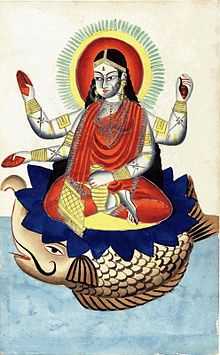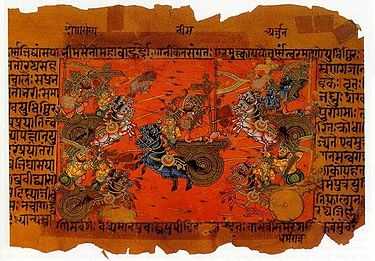Ganges in Hinduism
| Ganga | |
|---|---|
| Ganga River | |
 Late 19th-century Kalighat painting | |
| Devanagari | गंगा or गङ्गा |
| Sanskrit Transliteration | Gaṅgā |
| Affiliation | Devi, River |
| Abode | Brahmaloka or Brahmapura, Mount Kailash and Earth |
| Mantra | om ganga devvai namaha |
| Consort | Shantanu (Mahabharata), Shiva (Puranas) |
| Children | Bhishma (Mahabharata) |
| Mount | Makara |
In Hinduism, the river Ganga is considered sacred and is personified as a goddess known as Ganga. It is worshipped by Hindus who believe that bathing in the river causes the remission of sins and facilitates Moksha (liberation from the cycle of life and death) the water of Ganga is considered very pure. Pilgrims travel long distances to immerse the ashes of their kin in the precious water of the Ganges, bringing their spirits closer to moksha.
Several places sacred to Hindus lie along the banks of the Ganges, including Gangotri, Haridwar, Allahabad and Varanasi. During the Loy Krathong festival in Thailand, candlelit floats are released into waterways to honor the Buddha and the goddess Ganga (พระแม่คงคา, คงคาเทวี) for good fortune and washing away sins (pāpa in Sanskrit, used to describe actions that create negative karma by violating moral and ethical codes, which brings negative consequences.)
Legend
Bhagavata Purana depicts the birth of the Ganges. According to Bhagavata Purana, Lord Vishnu in one of his incarnations, appeared as Vamana in the sacrificial arena of Asura King Mahabali. Then in order to measure the universe, he extended his left foot to the end of the universe and pierced a hole in its covering with the nail of his big toe. Through the hole, the pure water of the Causal Ocean (Divine Brahm-Water) entered this universe as the Ganges River. Having washed the lotus feet of the Lord, which are covered with reddish saffron, the water of the Ganges acquired a very beautiful pink color. Because the Ganges directly touches the lotus feet of Lord Vishnu (Narayana) before descending within this universe, Ganges is known as Bhagavat-Padi which means Emanating from the lotus feet of Bhagavan (God). It finally settles in Brahmaloka or Brahmapura, abode of Lord Brahma before descending to planet Earth at the request of Bhagiratha and held safely by Lord Shiva on his head to prevent destruction of Bhumi (Mother Earth).[1] Then, the river Ganges was released from Lord Shiva 's hair to meet the needs of the country according to Hindu mythology. In other legends, Himavan fathered Parvati and Ganga .
Descent to earth

Several years later, a king named Sagara magically acquired sixty thousand sons. One day, King Sagara performed a ritual of worship for the good of the kingdom. One of the integral parts of the ritual was a horse, which was stolen by the jealous Indra. Sagara sent all his sons all over the earth to search for the horse. They found it in the nether-world (or Underworld) next to a meditating sage Kapila. Believing that the sage had stolen the horse, they hurled insults at him and caused his penance to be disturbed. The sage opened his eyes for the first time in several years, and looked at the sons of Sagara. With this glance, all sixty thousand were burnt to death.[2]
The souls of the sons of Sagara wandered as ghosts since their final rites had not been performed. When Bhagiratha, one of the descendants of Sagara, son of Dilip, learnt of this fate, he vowed to bring Ganga down to Earth so that her waters could cleanse their souls and release them to heaven.
Bhagiratha prayed to Brahma that Ganga come down to Earth. Brahma agreed, and he ordered Ganga to go down to the Earth and then on to the nether regions so that the souls of Bhagiratha's ancestors would be able to go to heaven. Ganga felt that this was insulting and decided to sweep the whole Earth away as she fell from the heavens. Alarmed, Bhagiratha prayed to Shiva that he break up Ganga's descent.
Ganga arrogantly fell on Shiva's head. But Shiva calmly trapped her in his hair and let her out in small streams. The touch of Shiva further sanctified Ganga. As Ganga travelled to the nether-worlds, she created a different stream to remain on Earth to help purify unfortunate souls there. She is the only river to follow from all the three worlds – Swarga (heaven), Prithvi (Earth) and, Patala (netherworld or hell). Thus is called "Tripathagā" (one who travels the three worlds) in Sanskrit language.
Because of Bhagiratha's efforts Ganga descended to Earth and hence the river is also known as Bhagirathi, and the term "Bhagirath prayatna" is used to describe valiant efforts or difficult achievements.
Another name that Ganga is known by is Jahnavi. Story has it that once Ganga came down to Earth, on her way to Bhagiratha, her rushing waters created turbulence and destroyed the fields and the sadhana of a sage called Jahnu. He was angered by this and drank up all of Ganga's waters. Upon this, the Gods prayed to Jahnu to release Ganga so that she could proceed on her mission. Pleased with their prayers, Jahnu released Ganga (her waters) from his ears. Hence the name "Jahnavi" (daughter of Jahnu) for Ganga.
It is sometime believed that the river will finally dry up at the end of Kali Yuga (the era of darkness, the current era) just as with the Sarasvati river, and this era will end. Next in (cyclic) order will be the Satya Yuga or the era of Truth.
Rigveda
Ganga is mentioned in the Rigveda, the earliest and theoretically the holiest of the Hindu scriptures. Ganga is mentioned in the nadistuti (Rigveda 10.75), which lists the rivers from east to west. In RV 6.45.31, the word Ganga is also mentioned, but it is not clear if the reference is to the river.
RV 3.58.6 says that "your ancient home, your auspicious friendship, O Heroes, your wealth is on the banks of the Jahnavi (JahnAvyAm)". This verse could possibly refer to the Ganges.[3] In RV 1.116.18–19, the Jahnavi and the Ganges River Dolphin occur in two adjacent verses.[4][5]
Other religious associations
.jpg)
According to the Hindu scriptures like Skanda Purana, the goddess Ganga is foster-mother to Karttikeya (Subrahmanya, Murugan), who was actually a son of Shiva and Parvati.
Parvati who created an image of Ganesha (son of Shiva and Parvati) out of her bodily impurities but which became endowed with life after immersion in the sacred waters of the Ganges. Therefore Ganesha is said to have two mothers—Pārvati and Gangā and hence called Dvaimātura and also Gāngeya (the son of Ganga).[6]
The Hindu epic, Mahabharata tells that the Vasus, cursed by Vashishta had requested Ganga to be their mother. Ganga incarnated and became the wife of King Santanu on condition that at no stage shall he question her actions, or she would leave him. As seven Vasus were born as their children, one after the other, Ganga drowned them in her own waters, freeing them from their punishment and the king made no opposition. Only when the eighth was born did the king finally oppose his wife, who therefore left him. So the eighth son, Dyaus incarnated, remained alive, imprisoned in mortal form, and later became known in his mortal incarnation as Bhishma (Devavrata), who is one of the most respected characters of the Mahābhārata.
Notes
- ↑ Bhagavata Purana, Canto 5, Chapter 17, Verses 1 - 10 (The Descent of the River Ganges)
- ↑ Sons of Sagara Vishnu Purana translated by Horace Hayman Wilson, 1840, Book IV, Chapter IV. p. 378 the gods repaired to the Muni Kapila, who was a portion of Vishńu, free from fault, and endowed with all true wisdom. Having approached him with respect, they said, "O lord, what will become of the world, if these sons of Sagara are permitted to go on in the evil ways which they have learned from Asamanjas! Do thou, then, assume a visible form, for the protection of the afflicted universe." "Be satisfied," replied the sage, "in a brief time the sons of Sagara shall be all destroyed.".
- ↑ Talageri, Shrikant. (2000) The Rigveda: A Historical Analysis; Talageri, S.: "Michael Witzel – An examination of his review of my book". --Griffith translates JahnAvyAm in this verse as "house of Jahnu", even though in similar verses he uses the "on the banks of a river" translation (see Talageri 2000)
- ↑ Talageri, Shrikant. (2000) The Rigveda: A Historical Analysis.; Talageri, S.: "Michael Witzel – An examination of his review of my book" 2001.
- ↑ The Sanskrit term shimshumara refers to the Gangetic dolphin (the Sanskrit term for dolphin is shishula). Talageri 2000, 2001 chandan singh kanyal
- ↑ Y. Krishan (Gaṇeśa:Unravelling an Enigma, p.6
References
- Vijay Singh: The River Goddess (Moonlight Publishing, London, 1994)
External links
| Wikimedia Commons has media related to Ganga. |
| Wikiquote has quotations related to: Ganges in Hinduism |
- The Life Of Ganga
- Ganga Ma: A Pilgrimage to the Source a documentary that follows the Ganges from the mouth to its source in the Himalayas.
- Sacred Ganges
| |||||||||||||||||||||||||

